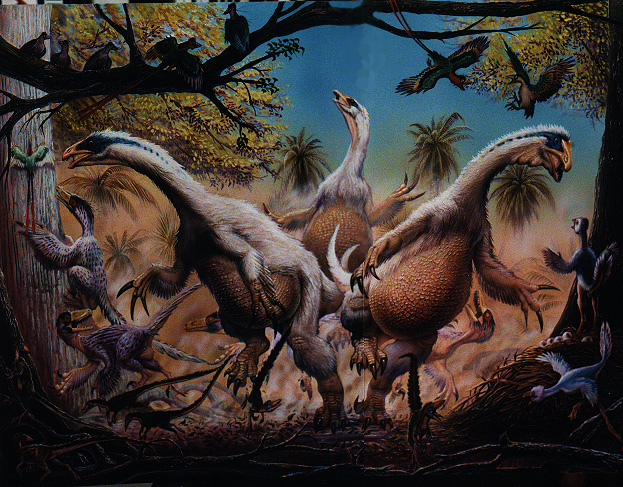
Beipiaosaurus inexpectus harassed by a band of indeterminate dromaeosaurs,
with Caudipteryx, Sinosauropteryx and Confuciusornis in the
foreground.
Click on image to see more detail! (There are 2 areas within this picture (more to follow!))

We owe to China, Ji Quang, Phil Currie and Mark Norell (amongst other paleontologists) for the definitive hard evidence that we needed to culminate the radical change and review of the anatomy, lifestyle and evolutionary relationships of dinosaurs that started with John Ostrom back in the sixties.
The artwork presented here shows a summary of the different stages of avian evolution. Not all the animals were contemporary so I used artistic license to recreate an allegorical landscape that would depict the full circle of theropod evolution.
It reconstructs fot the first time mid-size therinosaurs: Beipiaosaurus
inexpectus(see Asian
Dinosauria for an alternative view of gigantic therizinosaurs) covered
in the bristle (protofeathery?) insulation based on a recently discovered
Chinese specimen described in a long-awaited paper by Xing Xu, Zhi-lu Tang and
Xiao-lin Wang and published in the journal Nature on the 27th of May 1999 (No
6734).
The combination of the typical Therizinosaur anatomy and the bristle
covering give us a radical new view of this controversial animal: a cross
between a strange goose and extinct ground sloths. It pays tribute to the
foresight of Dale Russell, who was the first in speculating the mammal
convergence features in these dinosaurs.
Greg Paul described Therizinosaurs as the 'Sumo-dinosaurs' (because of the enormous and conspicuous bellies). It inspired me to reconstruct them with well armoured bellies so they would be less vulnerable to killer claws and teeth.
The discovery of Caudipteryx, with its arms and tail display fans of non flight feathers, incredibly short tail and peg-like teeth represented the ultimate realisation of Ostrom's dream, and Greg Paul's heretic feathered dinosaurs.
Feathered and insulated dinosaurs are no more a matter of speculation, and the Chinese discoveries shed light to clarify the intricate patterns of advanced avian evolution. Fully clawed but short tailed, beaked and toothless Confuciusornis is a good example with its mosaic of advanced and primitive features and its typical avian sexual dimorphism. The perfectly preserved fossil 'males' sport a dramatically long set of tail feathers as a display.
For more details on Sinosauropteryx see the page devoted to it in this Website.
Philip Currie backs the ground-up theories on the origin of flight. Luis Chiappe, Kevin Padian and Jacques Gauthier have been adamantly favouring the same theory for a long time... they see flight as a byproduct of the predatorial stroke from ancient dromaeosaurs that were already insulated and developed flight feathers. And they feel that all the hard evidence available at the moment and cladistic analyses agrees with them.
Others like Sankar Chattarjee, believe that some primitive dromaeosaurs took to the trees and became volant forms... and George Olshevsky who sees Caudipteryx and Protarchaeopteryx as secondarily flightless... just as the rest of the dinosaurs, who descended from arboreal forms in different stages of evolution.
What all of them (and the majority of paleontologists) agree now is that all of these animals are part of the clade known as the Dinosauria and are branches and twigs of the complicated evolutionary that gave rise to what we know as the modern Avian clade. Aves are simply the last surviving branch that has kept diversifying into a myriad of species, far back in time. Now even a fossil parrot has been found in Cretaceous sediments!
I have been advocating for a long time the old proposal to reconsider Dinosauria as a class, with Aves as a subclass. A bird can always be recognised as a bird... but a Sauropod, a Ceratopsian and a bird seem incongruous as close relatives... and yet, they are all Dinosauria.
The enormous variety of species that we consider dinosaurs merits this review.
With each new discovery, the depiction of dinosaurs is changing every minute. It is clear that we know very little about the external appearance of dinosaurs and some familiar-looking creatures may turn out to be more exotic and strange than we ever thought.
Quoting my expert friend Cristiano Dal Sasso** at the Society of Vertebrate Paleontology meeting this year: "We are barely starting to know dinosaurs... and there are too many surprises still waiting to be discovered..."
So... as Angela Milner would say "Watch this space!"
** Paleontologist at the Natural History Museum of Milan and original researcher and describer of Scipionyx samniticus, the perfectly preserved (guts and all) little Italian maniraptoran dinosaur. For more details see the following site that links to us ABC NEWS.